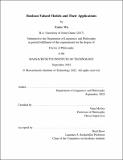Boolean-Valued Models and Their Applications
Author(s)
Wu, Xinhe
DownloadThesis PDF (599.2Kb)
Advisor
McGee, Vann
Terms of use
Metadata
Show full item recordAbstract
Boolean-valued models generalize classical two-valued models by allowing arbitrary complete Boolean algebras as value ranges. The goal of my dissertation is to study Boolean-valued models and explore their philosophical and mathematical applications.
In Chapter 1, I build a robust theory of first-order Boolean-valued models that parallels the existing theory of two-valued models. I develop essential model-theoretic notions like "Boolean-valuation", "diagram", "elementary diagram", and prove a series of theorems on Boolean-valued models, including the (strengthened) Soundness and Completeness Theorem, the Löwenheim-Skolem Theorems, the Elementary Chain Theorem, and many more.
Chapter 2 gives an example of a philosophical application of Boolean-valued models. I apply Boolean-valued models to the language of mereology to model indeterminacy in the parthood relation. I argue that Boolean-valued semantics is the best degree-theoretic semantics for the language of mereology. In particular, it trumps the well-known alternative - fuzzy-valued semantics. I also show that, contrary to what many have argued, indeterminacy in parthood entails neither indeterminacy in existence nor indeterminacy in identity, though being compatible with both.
Chapter 3 (a collaboration with Bokai Yao) gives an example of a mathematical application of Boolean-valued models. Scott and Solovay famously used Boolean-valued models on set theory to obtain relative consistency results. In Chapter 3, I investigate two ways of extending the Scott-Solovay construction to set theory with urelements. I argue that the standard way of extending the construction faces a serious problem, and offer a new way that is free from the problem.
Date issued
2022-09Department
Massachusetts Institute of Technology. Department of Linguistics and PhilosophyPublisher
Massachusetts Institute of Technology